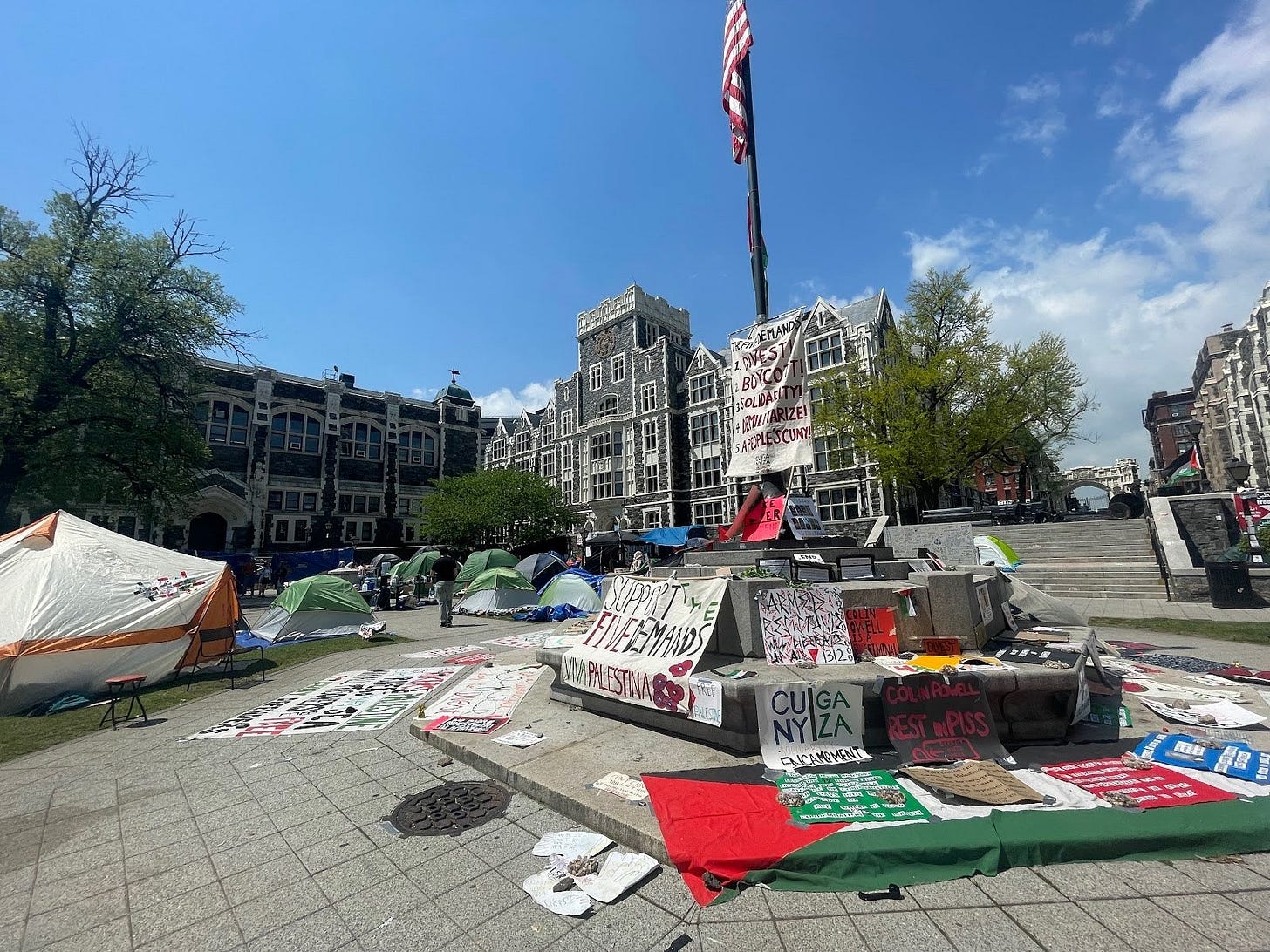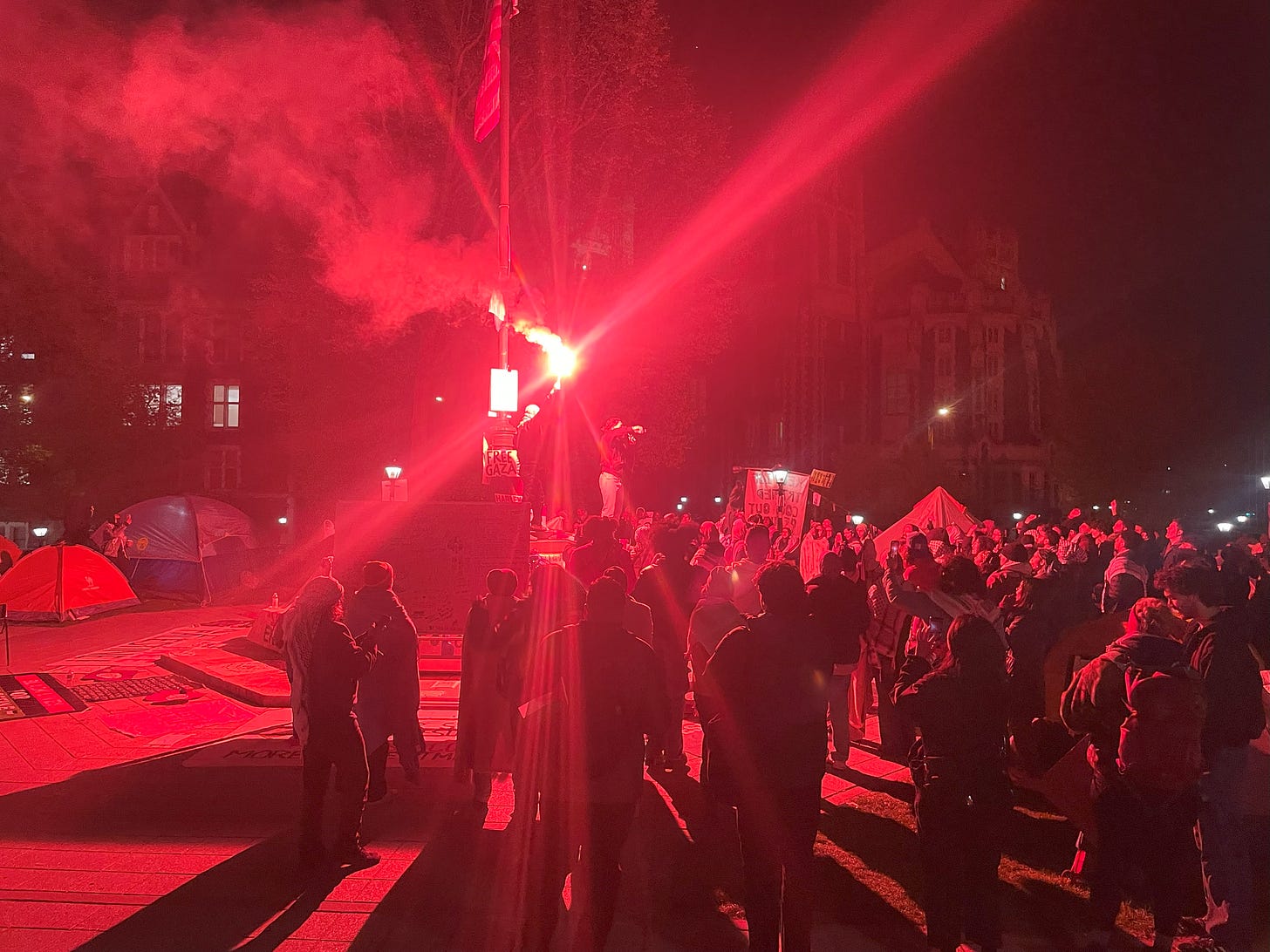In protest coverage prep, safety comes first
DC, NYC student journalists gear up to cover Israel-Hamas war protests

While covering on-campus protests was enjoyable for Leon Orlov-Sullivan, he also described the experience last semester as “hectic and stressful.”
Especially when it came to “dodging the police.”
“On the night they shut down the encampment, it was also pretty stressful to deal with the police at times,” said the editor-in-chief of The Campus Magazine at The City College of New York. “I was pretty high on adrenaline.”
Similarly at Georgetown University, Executive News Editor of The Georgetown Voice Franziska Wild said her reporters often feared being mistaken for protesters by cops.
“You might be wearing a press pass, you might be wearing a hat that says Georgetown Voice, but you also look like every single other protester,” she said. “There was definitely a sense that you’re at an acute risk here.”
As campus protests return, student journalists are bracing for what some have described as “absolute nightmare scenarios” — including the risk of being arrested or assaulted on the job.
This followed reports of student journalists being pepper sprayed by police, knocked down by cops, beaten by protesters and arrested last semester.
To prepare, Wild said The Voice is providing safety training for reporters who will be on the ground.
The training covers essential questions like how to maintain a safe distance, recognizing when police might take action, developing exit strategies and identifying safe spots to stand.
Wild credited News Editor Eddy Binford-Ross, who covered the Black Lives Matter protests in high school in Oregon, with helping develop these safety tips.
“We don't have a big outlet (that can) help us if we do accidentally get arrested,” she said. “We have our faculty advisor. But I don't think there's the same sense of security as when you're with a larger professional media outlet.”
Given that Georgetown has its own police force, Wild’s team is working to communicate with administrators, making them aware of their presence as media at protests to hopefully avoid potential clashes.
“We’re lucky that we have a very good communication staff,” Wild said. “We come to them for comments, we annoy them, but they also care about us students like people.”
At The Campus Magazine in New York, where the staff is much smaller — just three members — Orlov-Sullivan is focused on onboarding more people with the necessary skills to cover protests, including journalistic writing, reporting and working under pressure.
Asked how he trains new staffers who lack prior experience, he emphasized the importance of passion.
“Hopefully, that passion can be turned into a willingness to learn more about journalism,” Orlov-Sullivan said. “We don’t know how successful or unsuccessful we’re going to be in that endeavor.”
Reflecting on the coverage last semester, Orlov-Sullivan said it was his first time reporting on protests.
He learned the importance of being on the ground, talking to those involved and questioning narratives that circulate online, especially from those who weren’t there.
“With large protests that are sort of seemingly spontaneous, it takes diligence to understand what's going on,” he said.

🚨 Safety tips
The Student Press Law Center created a guide about your rights and how to stay safe while covering protests. It includes 20 tips such as always working with a buddy and recording any police encounter and going live.
Her Campus also has 20 safety tips including avoiding wearing items that can be grabbed or pulled and knowing the layout of the protest site to plan escape routes.
The Foundation for Individual Rights and Expression has an article about questions that student journalists frequently ask while covering a protest such as whether your college can demand to look over your content before publishing and whether you can record protesters when you’re at a private college.
San Francisco State University and the University of Massachusetts Amherst have student safety guides for reporting in the field from their journalism departments.
🔎 Zooming out
Colleges and universities came up with new restrictions around demonstrations and space usage ahead of this semester. Here’s what student journalists are saying:
The Observer at Case Western Reserve University called the university’s new rules that, in part, require any proposed demonstration to be pre-approved by a committee a policy that “hinders civic engagement on campus.”
The Cavalier Daily at the University of Virginia called the university’s handle of protests last semester that included state troopers’ use of chemical irritants “dystopian” and said new policies set the school up to repeat “the exact mistakes.”
The Campus Times at the University of Rochester said colleges across the country have adopted a clear message: “Never again shall students make the university look bad” and that they should be “absolutely ashamed of this bold-faced attempt” to limit expression.
The Berkeley Beacon at Emerson College viewed new rules as an “attempt to censor its students,” calling on journalists and journalism students to resist this suppression and use their voices to advocate for truth and justice.
📊 FIRE released its 2025 college free speech rankings last week, revealing that American confidence in higher education is at a record low. See how your institution does. Here are some highlights:
A record 1 in 3 students now say it's at least “rarely” acceptable for violence to stop a campus speech.
7 in 10 students find it acceptable to some extent to shout down a speaker.
📅 Happening Next Week:
Join this webinar to hear how college journalism prepared these young journalists for their first jobs/internships. Please share it with your network! Register here.
When? Wednesday, Sept. 18 at 5-6 p.m. ET
Story Spotlight:
Extra, extra: A year of stories from across UW student newspapers (The Daily Cardinal): A student journalist spoke to nine University of Wisconsin System student newspapers about balancing their lives as reporters and students. Some main themes? Burnout, resilience and the vital role of student journalism in covering campus and community issues.
Featured Opportunities:
The first wave of ABC News internships for spring 2025 is now live.
Telemundo has news internship openings in Miami, Tucson and Las Vegas.
iHeartMedia is looking for an intern for Elvis Duran Morning Show.
The New England First Amendment Coalition hosts a webinar on audio reporting Sept. 10.
The Online News Association conference is Sept. 18-21 in Atlanta. Apply to Student and New Professional Scholarship by Sept. 12.
A virtual panel titled “Navigating the Election with Students & Educating for American Democracy” takes place Sept. 17.
The Institute for Citizens and Scholars accepts entries from individuals aged 14-24 for its Youth Civic Solutions Competition until Oct. 4.
The National Association of Broadcasters Leadership Foundation Career Fair returns to Manhattan Oct. 10. It’s free for students.
ACES: The Society for Editing is accepting applications for six scholarships, with a deadline of Nov. 15.
I want to hear from you: How are you preparing for protest coverage? Is your student publication doing something cool that you’d like to share? Reach me at nutgrafnews@gmail.com. I will respond! Also, please share








